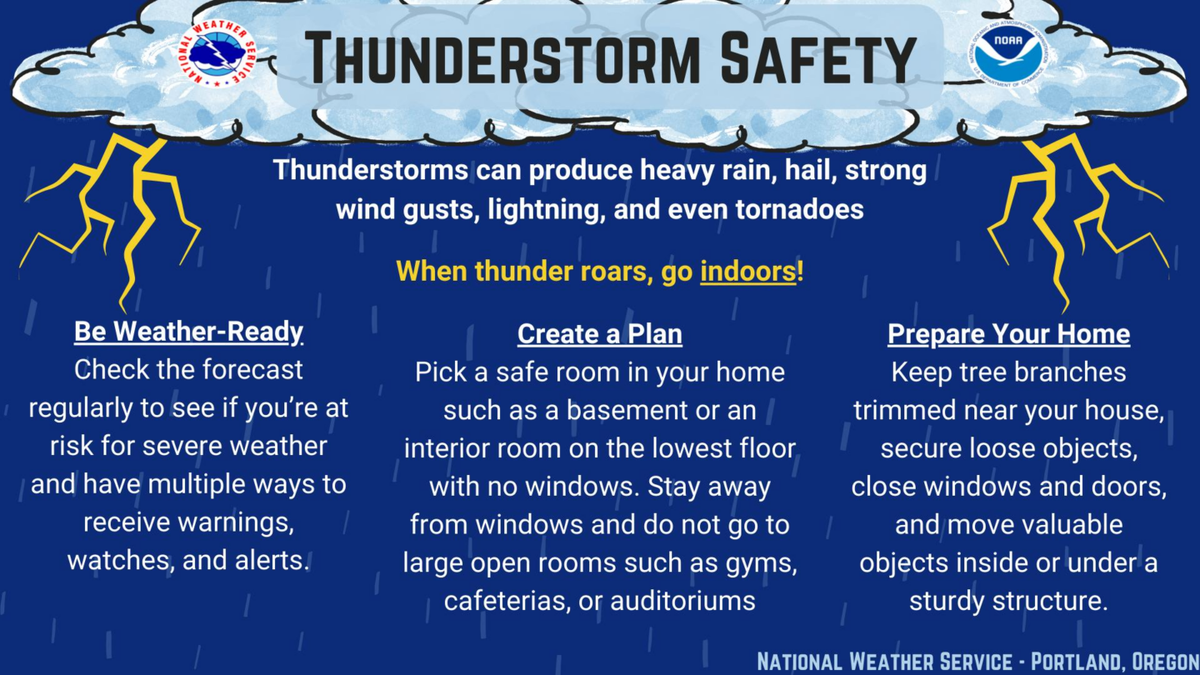State emergency managers, ODOT urge safety, travel caution as severe weather threat moves into western Oregon

SALEM, Ore. (KTVZ) — The National Weather Service says severe thunderstorms are expected across parts of the Pacific Northwest this afternoon and evening, with supercells possible west of the Cascades across Oregon into Washington, prompting the Oregon Department of Emergency Management to issue a list of safety tips.
These storms may produce large hail, perhaps a tornado or two, and strong wind gusts. The Oregon Department of Emergency Management is encouraging people to take caution when traveling in Western Oregon today. Even if the chance of a tornado or severe storm appears slight, preparing ahead of time can make a significant difference.
Lightning Safety
- When thunder roars, go indoors. If you see lightning or hear thunder, seek shelter inside a sturdy, enclosed building. Do NOT take shelter under trees or open-sided shelters like picnic areas.
- If shelter isn't available, a vehicle with a metal roof, turned off, with the windows closed is safer than remaining outside. Vehicles act as a Faraday cage and will disperse electrical strikes away from you into the ground.
Heavy Rain, Hail & Flooding
- Slow down while driving to avoid hydroplaning or sliding on hail-covered streets.
- Avoid driving through flooded roadways. Even a few inches can be deadly.
- Watch for water accumulation in low-lying areas.
Tornado Preparedness
- The safest place during a tornado is a basement. If that's not available, go to the lowest floor of your home in a small interior room—like a closet or bathroom—away from windows.
- Cover yourself with a mattress or sturdy object to protect against debris.
- If caught outside without shelter, lie in a ditch or culvert and cover your head.
Damaging Winds
- Remain indoors and away from windows.
- Don’t park under trees due to falling limb risk.
- Be aware that falling trees may impact power lines, buildings, and roadways.
- See additional tips for Staying Safe After a Windstorm.
Power Outage Preparedness
Severe weather can lead to power outages. Take these steps now to prepare:
- Charge mobile devices and backup battery packs.
- Assemble an emergency kit with flashlights, batteries, non-perishable food, drinking water, and necessary medications.
- Have a plan for medical devices that require electricity.
- Store extra blankets or cooling supplies, depending on the season.
- Have books, games, or activities on hand to help pass the time without electricity.
- See additional ’Tips to Stay Safe During Power Outages’
Farm & Livestock Safety
- Secure loose outdoor items like garbage cans, patio furniture, and tools.
- If possible, bring livestock indoors to barn or shelter. Animals often seek shelter under trees or along fences, both of which can be hazardous in thunderstorms.
For More Information
Visit the National Weather Service Thunderstorm Safety website: https://www.weather.gov/safety/thunderstorm
For travel conditions make sure to visit: TripCheck.com
Sign up for emergency alerts at: ORalert.gov
Stay informed by monitoring local weather reports and signing up for OR-Alert to receive emergency notifications directly to your phone. Preparedness today can protect lives tomorrow. Stay alert, stay safe, and be ready.
--
ODOT news release:
SALEM – While the sun may be shining now, don’t be caught off guard—severe weather is on the way. With many travelers on the road for spring break, the National Oceanic and Atmospheric Administration (NOAA) forecasts thunderstorms, heavy rain, and high winds across Oregon and the greater Northwest on Wednesday, potentially disrupting travel plans. Whether you're driving, using public transit or enjoying outdoor activities, be prepared for sudden weather changes and take necessary precautions to stay safe.
Key Hazards During Storms:
- Thunderstorms: Lightning, gusty winds, heavy rain and hail could create hazardous conditions for driving, biking and walking. Power outages and debris on roads are possible.
- High Winds: High winds may cause trees, limbs or powerlines to fall, potentially blocking roads and paths.
- Flooding: Heavy rain may lead to localized flooding, particularly on low-lying roads, bridges and areas near rivers. Heavy rain could also cause slides, blocking roads with debris.
- Reduced Visibility: Heavy rain and storm conditions may significantly reduce visibility, making travel more challenging.
Travel Safety Tips:
- On the Road:
- Slow down and drive with caution, particularly on wet roads.
- Be sure to turn on your headlights to improve your visibility and help others see you.
- Never drive through standing water, as it can be deeper than it appears and may hide hazards or cause your vehicle to stall.
- Keep a safe distance from other vehicles, especially when visibility is poor.
- Watch out for people walking and biking as they are less visible in bad weather.
- Public Transit:
- Expect possible delays or service interruptions due to weather conditions, particularly in flood-prone areas.
- Allow extra time for your journey and check with transit agencies or rail providers for updates.
- Biking & Walking:
- Avoid biking or walking in stormy conditions, especially in areas prone to flooding, as heavy rain and strong winds can pose serious hazards.
- If you must travel during the storm, stay vigilant and wear high visibility clothing.
- Prepare for the Unexpected:
- Keep an emergency kit in your vehicle, including water, snacks, a flashlight and a fully charged phone.
- Ensure your vehicle is well-maintained and equipped for rain or wet conditions, including working wipers and good tires.
Stay updated on current weather conditions and to check road conditions and closures at TripCheck.com or by calling 511 for real-time updates.
Stay safe, stay informed and adjust your travel plans accordingly.
